/category/landscapes/page/3/
Torii KIYOMITSU (1735-1785)
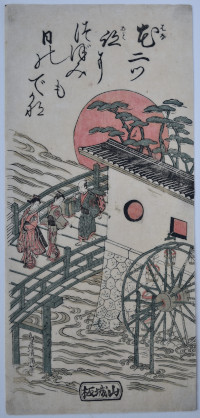
Click here to view image full size.
An hosoban showing two female travellers and their man-servant crossing a river beside a waterwheel, a giant sun on the horizon, the ancient symbol of Japan. Very few prints show waterwheels, the best known being Hokusa’s waterwheel at Onden from the 36 Views of Fuji set. They were in use until the 1880s and, apart from being used for irrigation, they were also employed to run grain mills to polish rice for making sake and threshing machines. Published by Yamashiro han c. 1759. Benizuri-e, with beni, green and blue (turned). Apparently unrecorded.
Fine impression. Very good colour and condition. Signed Torii Kiyomitsu hitsu.
Status: Sold
Utagawa HIROSHIGE II (1826-1869)
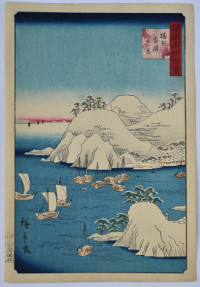
Click here to view image full size.
A snow scene showing Muro Harbour in Harima Province, Banshu Muro-tsu shinkei, “Actual View of Muro Harbour Banshu [Harima] Province.” From Shokoku meisho hyakkei, “One Hundred Famous Views in the Various Provinces.” The set published by Uoya Eikichi, 1859-61 (this being 1859). An uncompleted set with only 81 prints known. Beyond the harbour can be seen the Inland Sea, the Seto Inland Sea aka Setouchi.
Superb impression of the first edition. Fine colour and condition. Signed Hiroshige ga.
Status: Sold
Yashima GAKUTEI (1786?-1868)
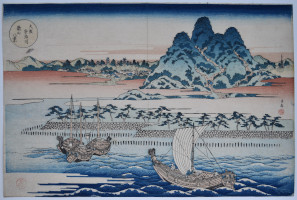
Click here to view image full size.
Osaka Ajigawa niiyama fukei, “View of the Aji River and the New Mountain in Osaka” from a set of six prints Naniwa meisho Tenpozan hajimari no zu, “Fine Views of Mount Tenpo at a Glance.” The mountain (more a hill) and park was created by dredging the Aji River. Shows a sailboat approaching the mouth of the river, Tenpozan to the right. In the distance can be seen Osaka Castle and to the right the Shitennoji pagoda. Published by Shioya Kisuke, c.1834.
Fine impression and colour. Slight vertical fold as per usual as the set was published in album form. Fine condition. Signed Gakutei.
Status: Sold
Utagawa HIROSHIGE (1797-1858)
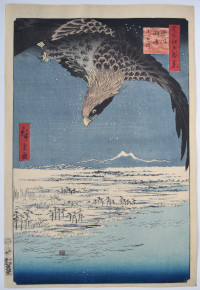
Click here to view image full size.
Fukagawa, Suzaki, Juman-tsubo, “The One Hundred Thousand Tsubo Plain, Suzaki, Fukagawa” from Meisho Edo hyakkei, “One Hundred Famous Views of Edo.” The set published by Uoya Eikichi between 1856 and 1859 (this being 1857). An eagle hovers over the snowy coastal plain, Mt Tsukuba and the Chiba mountains in the distance. Collectors at the beginning of the 20th century considered this the pre-eminent design from the set. Since then Ohashi has replaced it.
Fine impression, colour and condition. A nice early impression. Signed Hiroshige ga.
Status: Sold
Utagawa HIROSHIGE (1797-1858)
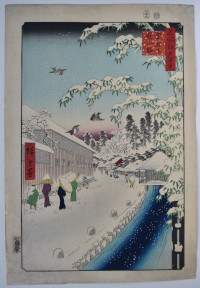
Click here to view image full size.
Atago shita Yabukoji, “Bamboo Lane Below Atago Hill” from Meisho Edo hyakkei, “One Hundred Famous Views of Edo.” The set published by Uoya Eikichi between 1856 and 1859 (this being 1857). A snow scene showing figures beside a stream, Atago Hill was to the right and lay just outside the northeast corner of the mansion of the daimyo of Minakuchi. It was the highest natural point in Edo.
Superb impression of the extremely rare first edition. Very fine colour. Left corner margin expertly restored, otherwise fine condition. Large margins. Signed Hiroshige ga.
Status: Sold
Utagawa HIROSHIGE (1797-1858)
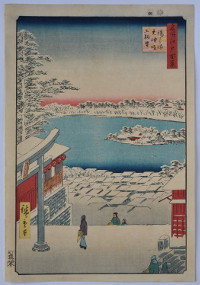
Click here to view image full size.
A snow scene: Yushima Tenjin sakaue chobo, “Hilltop View, Yushima Tenjin Shrine.” The shrine is dedicated to scholars and is near Ueno Park. From the set Meisho Edo hyakkei, “One Hundred Views of Edo.” The set published by Uoya Eikichi 1856-58 (this being 1856). The set comprises 118 prints by Hiroshige and another by Hiroshige II. However, three prints are dated 10/1858, the month following Hiroshige’s death, and these are thought to be by Hiroshige II as well. They are: Ueno Yamashita, Ichigaya Hachiman and Bikunibashi.
Fine impression, colour and condition. Signed Hiroshige hitsu.
Status: Sold
Utagawa HIROSHIGE (1797-1858)
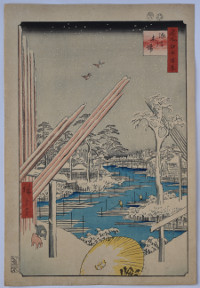
Click here to view image full size.
A snow scene: Fukagawa kiba, “Fukagawa Timber Yards.” The yards date back and are the result of the Meireki fire of 1657. Large amounts of wood was required for expanding Edo and the wood yards were moved to this area of swampland east of the Sumida River. From the set Meisho Edo hyakkei, “One Hundred Views of Edo.” The set published by Uoya Eikichi 1856-58 (this being 1856). The set comprises 118 prints by Hiroshige and another by Hiroshige II. However, three prints are dated 10/1858, the month following Hiroshige’s death, and these are thought to be by Hiroshige II as well. They are: Ueno Yamashita, Ichigaya Hachiman and Bikunibashi.
Fine impression, colour and condition. Signed Hiroshige hitsu.
Status: Sold
Utagawa HIROSHIGE (1797-1858)
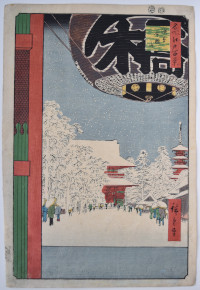
Click here to view image full size.
Asakusa Kinryuzan, “The Kinryuzan Temple at Asakusa” from Meisho Edo hyakkei, “One Hundred Famous Views of Edo.” The set published by Uoya Eikichi between 1856 and 1859 (this being 1856). A snow scene showing the oldest Buddhist temple in the city, the Sensoji or Asakusa Kannon, built on the low hill of Kinryuzan. Shows the Kaminarimon gate with the huge lantern with one character of the name shinbashi (a donor’s organisation).
Very good early impression and colour. Before the square plug becomes evident on the bottom left. Very good condition. Signed Hiroshige ga.
Status: Sold
Utagawa HIROSHIGE (1797-1858)
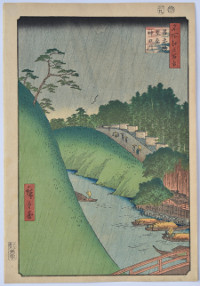
Click here to view image full size.
Shoheibashi Seido Kandagawa, “Seido Shrine and Kanda River Seen from Shohei Bridge.” The scene under light rain and is near present day Akihabara. From the set Meisho Edo hyakkei, “One Hundred Views of Edo.” The set published by Uoya Eikichi 1856-58 (this being 1857). The set comprises 118 prints by Hiroshige and another by Hiroshige II. However, three prints are dated 10/1858, the month following Hiroshige’s death, and these are thought to be by Hiroshige II as well. They are: Ueno Yamashita, Ichigaya Hachiman and Bikunibashi.
Superb impression of the first edition. Fine colour and condition. Signed Hiroshige ga.
Status: Sold
Utagawa HIROSHIGE (1797-1858)
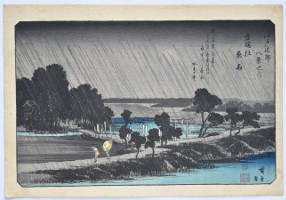
Click here to view image full size.
Azuma no mori yoru no ame, “Evening Rain at Azuma Shrine.” From a fine and rare early set Edo kinko hakkei, ”Eight Views in the Environs of Edo.” Shows figures walking along a dike beside the Kita Jumagawa. Azuma Shrine is seen amongst trees to the left. This set was first published privately for the Taihaido Poetry Club by the publisher Sanoya Kihei (Kikakudo) c 1837-8. (Similar to Hiroshige’s first set of fish prints.) For obvious reasons examples of these prints are of the utmost rarity. An entire set is in the Baur Collection, Matthi Forrer, 1994, nos. G492 – G499, this being G498. They have the copyright owner’s name in the left border, Taihaido Nomimasu, who was the head of the poetry club. They also have three poems on each design. The commercial edition, as here, has one or two poems and loses the Taihaido name. (Again, similar to the fish series.) These prints, initially not intended for commercial consumption, are more refined with a greater degree of care taken with the cutting of the blocks. Contrary to later sets, figures are small, pigments are subdued and large foreground objects are not in evidence yet. One of Hiroshige’s finest sets. Rare.
Very fine impression. Fine colour and condition with large margins. Signed Hiroshige ga.
Status: Sold
Utagawa HIROSHIGE (1797-1858)
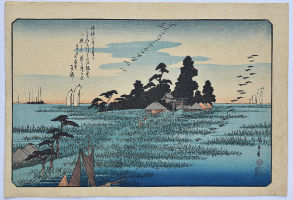
Click here to view image full size.
Haneda no rakugan, “Descending Geese at Haneda.” From a fine and rare early set Edo kinko hakkei, ”Eight Views in the Environs of Edo.” Planes now descend here. This set was first published privately for the Taihaido Poetry Club by the publisher Sanoya Kihei (Kikakudo) c 1837-8. (Similar to Hiroshige’s first set of fish prints.) For obvious reasons examples of these prints are of the utmost rarity. An entire set is in the Baur Collection, Matthi Forrer, 1994, nos. G492 – G499, this being G492. They have the copyright owner’s name in the left border, Taihaido Nomimasu, who was the head of the poetry club. They also have three poems on each design. The commercial edition, as here, has one or two poems and loses the Taihaido name. (Again, similar to the fish series.) These prints, initially not intended for commercial consumption, are more refined with a greater degree of care taken with the cutting of the blocks. Contrary to later sets, figures are small, pigments are subdued and large foreground objects are not in evidence yet. One of Hiroshige’s finest sets. Rare.
Very fine impression. Fine colour. Minimal edge soil, otherwise fine condition with large margins. Signed Hiroshige ga.
Status: Sold
Utagawa HIROSHIGE (1797-1858)
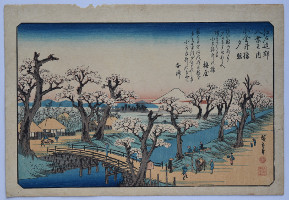
Click here to view image full size.
Koganeibashi no sekisho, “Evening Glow at Koganei Bridge.” From a fine and rare early set Edo kinko hakkei, ”Eight Views in the Environs of Edo.” This area was famous for its cherry trees and visitors are seen cherry viewing. It is also where the Tamagawa-josui was made to draw water from the Tama River into Edo. This set was first published privately for the Taihaido Poetry Club by the publisher Sanoya Kihei (Kikakudo) c 1837-8. (Similar to Hiroshige’s first set of fish prints.) For obvious reasons examples of these prints are of the utmost rarity. An entire set is in the Baur Collection, Matthi Forrer, 1994, nos. G492 – G499, this being G495. They have the copyright owner’s name in the left border, Taihaido Nomimasu, who was the head of the poetry club. They also have three poems on each design. The commercial edition, as here, has one or two poems and loses the Taihaido name. (Again, similar to the fish series.) These prints, initially not intended for commercial consumption, are more refined with a greater degree of care taken with the cutting of the blocks. Contrary to later sets, figures are small, pigments are subdued and large foreground objects are not in evidence yet. One of Hiroshige’s finest sets. Rare.
Very fine impression. Fine colour. Small edge nibble on top border and minimal edge soil, otherwise fine condition with large margins. Signed Hiroshige ga.
Status: Sold
Ichiryusai HIROSHIGE (1797-1858)

Click here to view image full size.
A rare ko-tanzaku design, Tsukudajima natsu no kei, “Summer View of Tsukudajima Island.” From a Toto meisho set published by Shogendo, c. 1837-8. Shows a large fishing boat beneath a bursting rocket; Tsukudajima in the background. There is another version of this design with a halo of light falling from the bursting rocket. This impression is so fine, I am surmising this is the earliest state.
Very fine early impression with strong woodgrain visible. Fine colour and condition. Signed Hiroshige ga.
Status: Sold
Katsushika HOKUSAI (1760-1849)
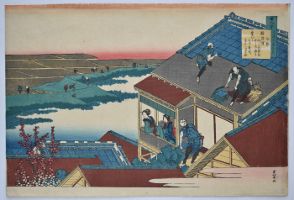
Click here to view image full size.
A design interpreting a poem by the Lady of Ise (c. 875-c. 938) from an unfinished set Hyakunin isshu uba ga etoki, “The Hundred Poems [By the Hundred Poets] as Told by the Nurse.” Published 1835-36 by Eijudo with 27 prints known and 67 outstanding drawings for the set. Shows a mother and daughter or lady and servant at a window overlooking Naniwa Inlet with rice fields in the distance and men working on the roof of the building they are in.
Fine early impression with woodgrain showing on the roof. Fine colour. Small nick out of right edge, otherwise fine condition. Signed Zen Hokusai manji.
Status: Sold
Utagawa KUNITORA (Active early 19th c.)
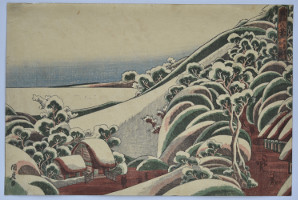
Click here to view image full size.
An aiban yoko-e print from an extremely rare and fine set of prints published 1810s by Yamasho. Kunitora’s finest set. Hira bosetsu, “Evening Snow at Mount Hira” from a set Omi hakkei, “Eight Views of Omi.” The set employs strong Western elements with hatching and sinuous hills and houses. Four designs from the set are illustrated in The Western-Style Colour-Prints In Japan, Usaburo Toyama, 1936, nos. 180-183 (this design being 182). A wonderful design.
Fine impression, colour and condition. Oxidation on the title label. Signed Kunitora ga.
Status: Sold
Utagawa HIROSHIGE (1797-1858)
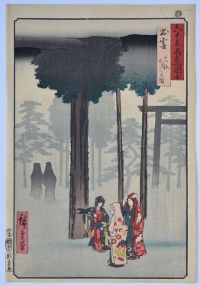
Click here to view image full size.
The great shrine at Izumo, Izumo, taisha hotohoto no zu from Rokujuyoshu meisho zue, “Famous Views in the Sixty-odd Provinces.” The set published by Koshimuraya Heisuke, 1853-6 (this being 1854). Shows a group of three young women bringing offerings to the Shinto shrine. A large cryptomeria tree in the foreground and other figures, trees and a torii in the misty background. The main deity of the shrine is Okuninushi no Okami, patron of good relationships and marriage (which probably accounts for the women’s visit). A beautiful design when well printed.
Fine early impression: Should have applied bokashi across the foreground area, as here. Fine colour. Slight vertical crease in left margin, otherwise fine condition. Signed Hiroshige hitsu.
Status: Sold
Katsushika HOKUSAI (1760-1849)
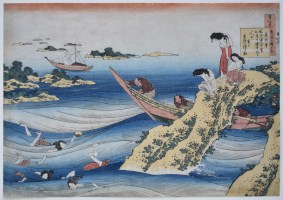
Click here to view image full size.
Hokusai’s interpretation of a poem by Ono no Takamura (802-852). From an unfinished set: Hyakunin isshu uba ga etoki, “Pictures of One Hundred Poems by One Hundred Poets Explained by the Nurse.” The poems are from an anthology Hyakunin isshu, “One Hundred People, One Poem Each” compiled by the poet Fujiwara no Teika (1162-1241). The poem was composed on the eve of Takamura’s banishment to an isolated island, later to be pardoned by the Emperor. (His boat can be seen in the distance.) One of Hokusai’s most beautiful prints showing women divers (ama) fishing for abalone (awabi). The divers are seen between waves reminiscent of a Victorian theatre stage set. Published by Eijudo, 1835-1836. A considerable number of original drawings exist for the set that were not turned into prints and are in various museums and private collections.
Fine impression and colour. Very slight edge soil, otherwise very good condition. Signed Saki no Hokusai.
Status: Sold
Utagawa KUNISADA (1786-1865)
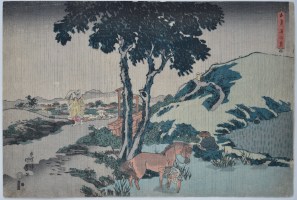
Click here to view image full size.
Samidare no kei, “Summer Rain” from an untitled set of eight landscapes published by Kinkodo c. 1832. Shows a man washing a horse in light rain. A group of pilgrims appear over a hill to the left. Part of the scene is based on an illustration from Kawamura Bumpo’s Bumpo sansui gafu of 1824. There are various states of this print. This is the earliest and most successful with the rain printed in green (not black) and the rain splashing in the river bottom right is blind-printed, not inked-in. Rare.
Fine impression and colour. Imperceptible centre fold, otherwise very good condition. Full size. Signed Kochoro Kunisada ga.
Status: Sold
Utagawa HIROSHIGE (1797-1858)
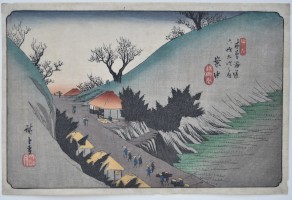
Click here to view image full size.
Station Annaka from Kisokaido rokujukyutsugi no uchi, “Sixty-nine Stations of the Kisokaido.” Published by Kinjudo, the set was started by Eisen in 1835 who designed twenty-four prints before Hiroshige replaced him and completed the series before 1843. Shows the entourage of a feudal lord progressing along the road between rest houses.
Very fine impression of the earliest printing. Fine colour and condition. Signed Hiroshige g
Status: Sold
Ichiyusai HIROSHIGE II (1826-1869)
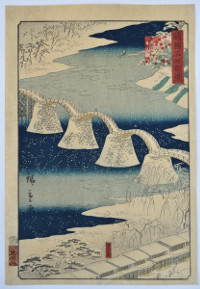
Click here to view image full size.
Suo Iwakuni Kintaibashi, “The Bridge of the Brocade Sash at Iwakuni in Suo Province.” From an uncompleted set: Shokoku meisho hyakkei, “One Hundred Views of the Provinces.” Published by Uoei between 1859 – 1861 (this being 1859). Shows the beautiful five-arch bridge spanning the Nishiki-gawa under heavy snow. The village of Nishikimi in the foreground. The bridge was built in 1673 using massive stone pilings because earlier bridges had been swept away. It was destroyed in 1950 due to a typhoon but rebuilt in 1953. The best print from the set and probably Hiroshige IIs finest design.
Fine impression of the first edition with mica applied. Fine colour. Minor edge discolouration, otherwise very good condition. Later editions lack the variegated cartouche and the colour-banded publisher’s seal in left margin. Signed Hiroshige ga.
Status: Sold
Utagawa HIROSHIGE (1797-1858)
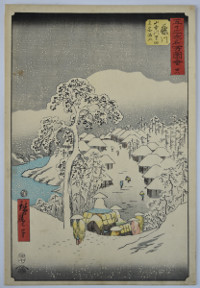
Click here to view image full size.
Fujikawa from the so-called “Upright Tokaido.” One of the two snow scenes from the set. Shows travellers coming and going at the edge of the village. Published by Tsutaya, Hare 7 (1855).
Very good impression and colour. Several small blemishes, otherwise very good condition. Signed Hiroshige ga.
Status: Sold
Utagawa HIROSHIGE (1797-1858)
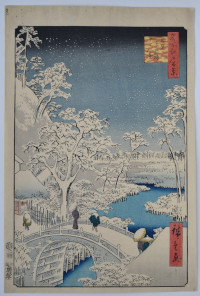
Click here to view image full size.
A snow scene: Meguro taikobashi yuhi no oka, “Drum Bridge and Sunset Hill, Meguro” from Edo meisho hyakkei, “The Hundred Famous Views of Edo.” Shows the valley of the Meguro River with travellers crossing the stone bridge, Yuhi Hill to the left. Stone bridges were uncommon in Edo because of the risk from earthquakes. Published by Uoya Eikichi between Ansei 3 and 5 (1856-58). This design dated Snake 4 (1857).
Very good impression, colour and condition. Signed Hiroshige ga.
Status: Sold
Utagawa HIROSHIGE (1797-1858)
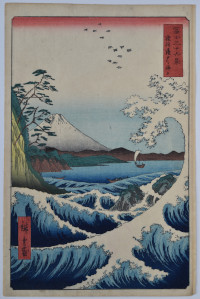
Click here to view image full size.
Suruga Satta no kaijo, “The Sea at Satta, Suruga Province” from Fuji sanjurokkei, “The Thirty-Six Views of Fuji.” The best design from the set published by Koeido (Tsutaya Kichizo), 4/1858. A huge wave breaks on the right releasing a flock of chidori. These birds were supposed to originate from the spume of these waves. Originally, travellers on the Tokaido had to traverse the base of the cliff, to the left. However, in 1655, a pass was cut in the cliff above. Fuji rises above the bay of Kiyomi. A popular design.
Very good impression and colour. Crease in right hand margin, otherwise very good condition. Signed Hiroshige ga.
Status: Sold
Utagawa HIROSHIGE (1797-1858)
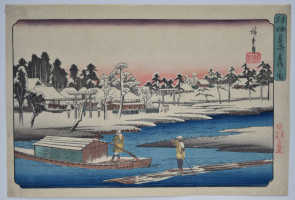
Click here to view image full size.
Masaki yukibare no zu, “Clear Weather After Snow at Masaki” from a Toto meisho, “Famous Sights of the Eastern Capital” set published by Kikakudo (Sanoki), the seal in red in right margin, c 1832-35. (Late editions have the seal in black.) There is confusion over how many prints belong to this series: The original set of twenty-one prints seems to have been extended to fifty-five in c 1839-42. The temple, under a deep layer of snow, is shown on the far shore. In the foreground two figures in yellow straw coats navigate the river.
Fine impression, colour and condition. Signed Hiroshige ga.
Status: Sold
Utagawa HIROSHIGE (1797-1858)
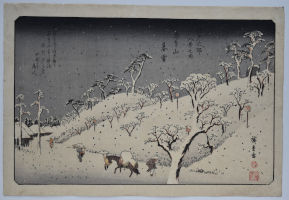
Click here to view image full size.
Asukayama bosetsu, “Evening Snow on Asuka Hill.” From a fine and rare early set Edo kinko hakkei, “Eight Views in the Environs of Edo.” Shows figures struggling through the deep snow. This set was first published privately for the Taihaido Poetry Club by the publisher Sanoya Kihei (Kikakudo) c 1837-8. (Similar to Hiroshige’s first set of fish prints.) For obvious reasons examples of these prints are of the utmost rarity. An entire set is in the Baur Collection, Matthi Forrer, 1994, nos. G492-G499. They have the copyright owner’s name in the left border, Taihaido Nomimasu, who was the head of the poetry club. They also have three poems on each design. The commercial edition, as here, has one or two poems and loses the Taihaido name. (Again, similar to the fish series.) These prints, initially not intended for commercial consumption, are more refined with a greater degree of care taken with the cutting of the blocks. Contrary to later sets, figures are small, pigments are subdued and large foreground objects are not in evidence yet. One of Hiroshige’s finest sets and this is one of his finest designs. Rare.
Very fine impression. Fine colour and condition with large margins and splashed gofun. Signed Hiroshige ga.
Status: Sold
Utagawa HIROSHIGE (1797-1858)
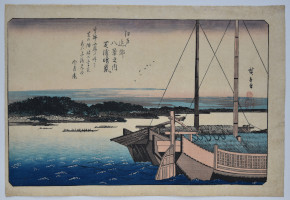
Click here to view image full size.
Shibaura no seiran, “Clearing Weather at Shiba Bay.” From a fine and rare early set Edo kinko hakkei, “Eight Views in the Environs of Edo.” Shows boats anchored on the edge of Edo Bay. This set was first published privately for the Taihaido Poetry Club by the publisher Sanoya Kihei (Kikakudo) c 1837-8. (Similar to Hiroshige’s first set of fish prints.) For obvious reasons examples of these prints are of the utmost rarity. An entire set is in the Baur Collection, Matthi Forrer, 1994, nos. G492-G499. They have the copyright owner’s name in the left border, Taihaido Nomimasu, who was the head of the poetry club. They also have three poems on each design. The commercial edition, as here, has one or two poems and loses the Taihaido name. (Again, similar to the fish series.) These prints, initially not intended for commercial consumption, are more refined with a greater degree of care taken with the cutting of the blocks. Contrary to later sets, figures are small, pigments are subdued and large foreground objects are not in evidence yet. One of Hiroshige’s finest sets. Rare.
Very fine impression. Fine colour and condition with large margins. Signed Hiroshige ga.
Status: Sold
Utagawa HIROSHIGE (1797-1858)
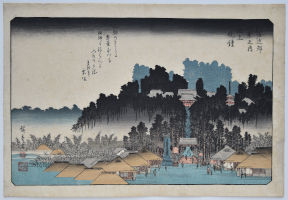
Click here to view image full size.
Ikegami no bansho, “Evening Bell at Ikegami.” From a fine and rare early set Edo kinko hakkei, “Eight Views in the Environs of Edo.”The otherwise nondescript town is famous for the large temple overlooking it. This was the Ikegami Honmonji, the main temple of the Lotus sect, a branch of Buddhism founded by Nichiren. This set was first published privately for the Taihaido Poetry Club by the publisher Sanoya Kihei (Kikakudo) c 1837-8. (Similar to Hiroshige’s first set of fish prints.) For obvious reasons examples of these prints are of the utmost rarity. An entire set is in the Baur Collection, Matthi Forrer, 1994, nos. G492-G499.They have the copyright owner’s name in the left border, Taihaido Nomimasu, who was the head of the poetry club. They also have three poems on each design. The commercial edition, as here, has one or two poems and loses the Taihaido name. (Again, similar to the fish series.) These prints, initially not intended for commercial consumption, are more refined with a greater degree of care taken with the cutting of the blocks. Contrary to later sets, figures are small, pigments are subdued and large foreground objects are not in evidence yet. One of Hiroshige’s finest sets. Rare.
Very fine impression. Fine colour and condition with large margins. Signed Hiroshige ga.
Status: Sold
Utagawa HIROSHIGE (1797-1858)
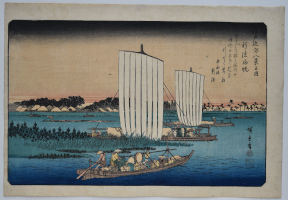
Click here to view image full size.
Gyotoku no kihan, “Returning Sails at Gyotoku.” From a fine and rare early set Edo kinko hakkei, “Eight Views in the Environs of Edo.” Gyotoku was a prosperous area on the Edogawa and Edo Bay. This set was first published privately for the Taihaido Poetry Club by the publisher Sanoya Kihei (Kikakudo) c 1837-8. (Similar to Hiroshige’s first set of fish prints.) For obvious reasons examples of these prints are of the utmost rarity. An entire set is in the Baur Collection, Matthi Forrer, 1994, nos. G492-G499. They have the copyright owner’s name in the left border, Taihaido Nomimasu, who was the head of the poetry club. They also have three poems on each design. The commercial edition, as here, has one or two poems and loses the Taihaido name. (Again, similar to the fish series.) These prints, initially not intended for commercial consumption, are more refined with a greater degree of care taken with the cutting of the blocks. Contrary to later sets, figures are small, pigments are subdued and large foreground objects are not in evidence yet. One of Hiroshige’s finest sets. Rare.
Very fine impression. Fine colour and condition with large margins. Signed Hiroshige ga.
Status: Sold
Utagawa HIROSHIGE (1797-1858)
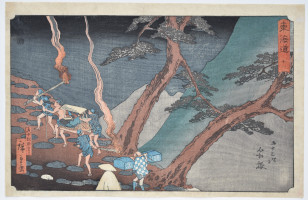
Click here to view image full size.
Hakone from the “Reisho” Tokaido. So-called because of the titles written in formal script. The best Tokaido set after the Hoeido. Shows travellers holding pine-torches climbing a mountain path at night. The Hakone mountains were one of the most gruelling parts of the Tokaido, but at the same time one of the most relaxing with the hot springs, Lake Ashi and the fine cryptomeria trees. Published by Marusei, c 1851-2. One of the five best designs from the set and probably the masterpiece. The composition and use of kimetsubishi to show the woodgrain in the night sky and mountains makes it one of Hiroshige’s most beautiful prints.
Very good impression, colour and condition. Signed Hiroshige ga.
Status: Sold
Utagawa KUNIYOSHI (1797-1861)
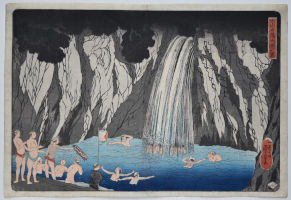
Click here to view image full size.
A view of pilgrims bathing in the Roben waterfall at the Afuri (Shinto) shrine, Oyama in Segami Province. Oyama sekison otaki no zu. This happened during the summer months and was considered a purification ritual. Oyama is a sacred mountain near the Izu peninsula and a short distance from Kamakura and Enoshima. Kuniyoshi designed another oban of this subject as well as two triptychs. Published by Wakasaya Yoichi, 1839-40. It has been suggested that the tattooed figure, on the left, holding a lantern with Kuniyoshi inscribed on it may be Kuniyoshi himself.
Very good impression and colour. Slight centre fold and expertly repared wormage. Signed Ichiyusai Kuniyoshi ga.
Status: Sold
Yashima GAKUTEI (1786 ?-1868)
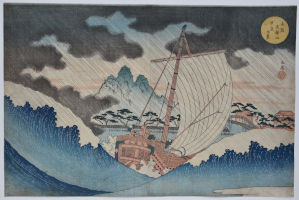
Click here to view image full size.
A saling junk caught in stormy seas, driving rain, and under a threatening sky. The masterpiece from a set of six prints issued in album form with title Naniwa meisho, Tempozan shokei ichiran, “A Famous Place in Osaka, Selected Views of Mount Tempo.” Published in Osaka , 1834, by Shioya Kisuke. In the circular cartouche: Osaka Tempozan yudachi no kei, “View of a Storm at Tempozan, Osaka.” Gakutei is best known for his many surimono. He was also a kyoka poet and painter. Unfortunately, he only produced a few landscapes. Other impressions illustrated in Michener, Japanese Prints, no. 198; Mellor sale catalogue, Sotheby, July 1963, pl. XXXI; Grabhorn, Landscape Prints of Old Japan, pl. 30.SC1/344. One of the great 19th century landscapes.
Fine impression and colour. Slight centre fold (as usual as it was published in folding album form), otherwise very good condition. Signed Gogaku with seal Go.
Status: Sold
Utagawa HIROSHIGE (1797-1858)
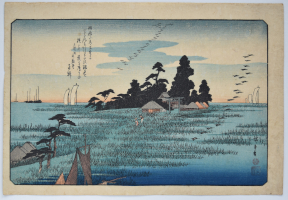
Click here to view image full size.
Haneda no rakugan, “Descending Geese at Haneda.” From a fine and rare early set Edo kinko hakkei, “Eight Views in the Environs of Edo.” Planes now descend here. This set was first published privately for the Taihaido Poetry Club by the publisher Sanoya Kihei (Kikakudo) c 1837-8. (Similar to Hiroshige’s fish prints.) For obvious reasons examples of these prints are of the utmost rarity. An entire set is in the Baur Collection, Matti Forrer, 1994, nos. G492 – G499, this being G492. They have the copyright owner’s name in the left border, Taihaido Nomimasu, who was the head of the poetry club. They also have three poems on each design. The commercial edition, as here, has one or two poems and loses the Taihaido name. (Again, similar to the fish series.) These prints, initially not intended for commercial consumption, are more refined with a greater degree of care taken with the cutting of the blocks. Contrary to later sets, figures are small, pigments are subdued and large foreground objects are not in evidence yet. One of Hiroshige’s finest sets. Rare.
Very fine impression. Fine colour. Minimal edge soil, otherwise fine condition with large margins. Signed Hiroshige ga.
Status: Sold
Utagawa HIROSHIGE (1797-1858)
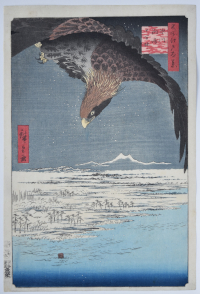
Click here to view image full size.
Fukagawa, Suzaki, juman-tsubo, “The One Hundred Thousand Tsubo Plain, Suzaki, Fukagawa” from Meisho Edo hyakkei, “One Hundred Famous Views of Edo.” The set published by Uoya Eikichi between 1856 and 1859 (this being 1857). An eagle hovers over the snowy coastal plain, Mt Tsukuba and the Chiba mountains in the distance. Collectors at the beginning of the 20th century considered this the pre-eminent design from the set. Since then Ohashi has replaced it.
Very good impression, colour and condition. Signed Hiroshige ga.
Status: Sold
Utagawa HIROSHIGE (1797-1858)
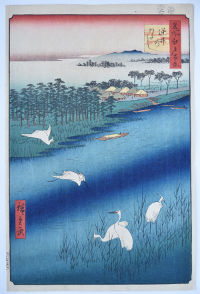
Click here to view image full size.
Sakasai no watashi, “Ferry at Sakasai” from Meisho Edo hyakkei, the “One Hundred Famous Views of Edo.” The set published by Uoya Eikichi between 1856 and 1858, this being 1857. The set shows famous sights, popular annual events, and festivals in and around Edo in the four seasons. Two Chinese egrets are seen flying down to join other egrets on the Nakagawa. The ferry is seen in the background.
Very fine impression of the first edition. Fine colour and condition. Signed Hiroshige ga.
Status: Sold
Utagawa HIROSHIGE (1797-1858)
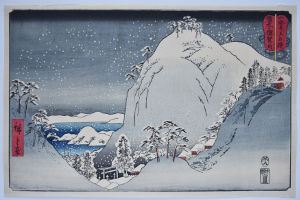
Click here to view image full size.
A snow scene Bizen Yugayama, “Mount Yuga in Bizen [Province].” From a set of 20 prints Sankai mitate sumo, “Mounains and Sea Contending Like Wrestlers.” The title is in a sumo umpire’s fan (a gunbai). There are 10 prints of mountains and 10 prints of harbours. The set was published by Yamadaya in 1858 (except for Etchu Tateyama which was published by Marujin). A beautiful print.
Fine impression, colour and condition. There is an anomaly here (as sometimes happens in Ukiyo-e): The first edition of this set has a variegated cartouche. However, the impression here is unquestionably the earliest but has only a one-colour cartouche. Signed Hiroshige ga.
Status: Sold
Utagawa HIROSHIGE (1797-1858)
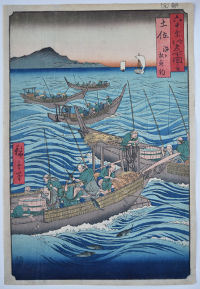
Click here to view image full size.
Tosa, kaijo katsuo tsuri, “Tosa [Province], Bonito Fishing at Sea.” From a set of 69 prints [Dai Nihon] Rokujuyoshu meisho zue, “Famous Places in the Sixty-odd Provinces [of Japan]” published by Koshihei between 1853 and 1856, this being 1855. Tosa, located on the southern coast of the island of Shikoku, was famous for its bonito.
Very fine impression of the first edition. Fine colour and condition. Signed Hiroshige ga.
Status: Sold
Utagawa HIROSHIGE II (1826-1869)
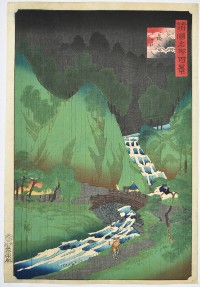
Click here to view image full size.
Mino Ochiai-bashi. Mino (Noshu) Province from the “Hundred Views of Famous Places in the Provinces.” An uncompleted set of 81 prints published by Uoya Eikichi between 1859 – 1861 (this being 1861). An evening rain scene with figures making their way across the torrential Chitose River, famous for its fishing.
Very fine impression of the first edition. Fine colour and condition. Signed Hiroshige ga.
Status: Sold
Utagawa HIROSHIGE (1797-1858)
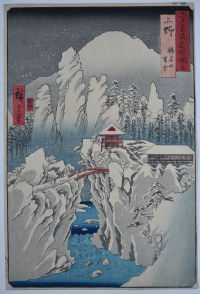
Click here to view image full size.
Kozuke, Harunasan setchu, “Kozuke [Province], Mount Haruna Under Snow.” From a set of 69 prints [Dai Nihon] Rokujuyoshu meisho zue, “Famous Places in the Sixty-odd Provinces [of Japan]” published by Koshihei between 1853 and 1856, this being 1853. A red bridge spans a gorge with precipitous cliffs and a fast flowing river. Fantastic crags point upwards into the sky. In the distance is Mount Haruna – a sleeping volcano.
Very good impression. Good colour. Trimmed close, otherwise good condtion. Signed Hiroshige ga.
Status: Sold
Katsushika HOKUSAI (1760-1849)
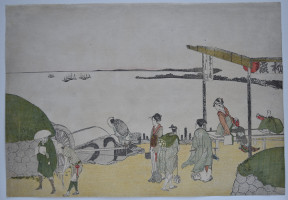
Click here to view image full size.
A street scene with travellers, an ox cart and a teahouse at the Okido gate, Takanawa, in Edo bay to the south-east of Edo. This stretch of coast leading to Shinagawa was lined with stalls and restaurants and very popular. The gate – the stone remains of which can be seen on the left and right – was the last travellers passed through on the Tokaido road to Edo. Another impression is in MFA Boston (21.10262, ex Spaulding via Frank Lloyd Wright) and a third in the BM (1937-0710-0-209).
Fine impression, colour and condition.
Status: Sold
Utagawa KUNIYOSHI (1797-1861)
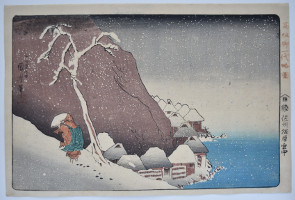
Click here to view image full size.
A snow scene showing Nichiren struggling up a snow-covered mountain near Tsukahara on the Island of Sado. The best design from Koso goichidai ryakuza, the “Illustrated Abridged Biography of the Founder.” Nichiren being the founder of the Buddhist Nichiren sect (Nichiren shu – Kuniyoshi being a follower) and indeed the set of ten prints may have been commissioned to mark the 550th anniversary of his death. Published by Iseya Rihei, c. 1831. Like many great landscapes, there exist different states which causes confusion over which is the earliest. The version offered here has the mountain printed in brown. Other impressions keep the mountain white. The other basic difference is that the design is known with and without a horizon line and that there is at least one impression where the un-inked, blind-printed line can be seen in a raked light. It has been asserted that those impressions without are the earliest; however, it seems from this that the sumi block was probably cut initially with the line but the publishers thought that it looked aesthetically better without printing it, and it was subsequently removed. In any case, this is a rare print and most surviving examples appear to be similar in impression. There is a break in the border to the left of the bottom of Kuniyoshi’s signature which could give a guide to the earliest states, but as this is often painted in, it is not reliable. The composition is based on a design in the illustrated book Bumpo sansui gafu by Kawamura Bumpo, published posthumously in 1824.
Very good impression, colour and condition with splashed gofun. Signed Ichiyusai Kuniyoshi hitsu.
Status: Sold